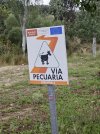The oldest Christian pilgrimage routes in Spain, short local ones excepted, are Cádiz > Rome (and the secondary routes attached to it, including those joining it via Catalonia and the Eastern Pyrenees towards Perpignan) ; and Western/Northern Spain & Portugal > Rome via more or less the French Piémont Way >> Béziers, albeit not on the current French route, and its own subsidiary routes.
The newest routes in Spain are the ones leading to Fátima, as it really is only just
starting to become a destination for foot pilgrimages beginning outside of Portugal -- but there's a Madrid > Fátima and a Burgos > Fátima -- though most of Burgos > Fátima is actually on the Lisbon > Rome Way, so "newest" is quite relative.
As to the history of the establishment of the various routes to Santiago with relation to the Reconquista, hard to tell. The Primitivo is not really older than the Francès, as in years when relationships were better, Iberian Muslims would not impede the passage of Christian pilgrims, so that even very early on some would take what eventually became the Francès.
The Catalan Way is quite old, as it is a route to Rome that has additionally become a
Camino de Santiago and an Ignatian Way, plus a route to Montserrat which is a major pilgrimage destination in its own right. Similar is likely true of the Camino de Castilla y Aragón.
It's true anyway that the first Caminos tended to be Ways to Rome & Jerusalem walked in "reverse", so that the Roman roads that the Francès is based around would have been Ways to Rome long before they ever became a Way to Compostela -- though Lugo and Ourense would have been the "starting" points for it in Galicia.
Conversely then, that means that the newer Camino routes are those that are not sensible Ways to Rome, so ones like the Madrid, Sureste, VDLP, Português, Mozarabe and so on, despite being historic, are not as old as the Francès and Primitivo/Norte, the Catalan, and so on that are Ways of both St. Peter and St. James. Another older one is the Vasco Interior, as some pilgrims would head to Rome via Burgos > Vitoria > Irun > Hendaye > Bayonne.































